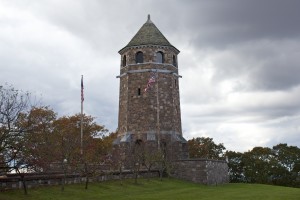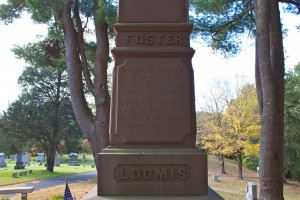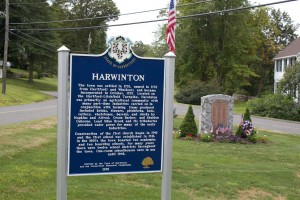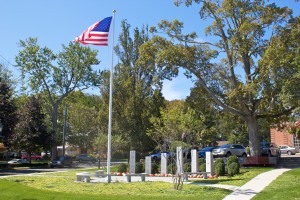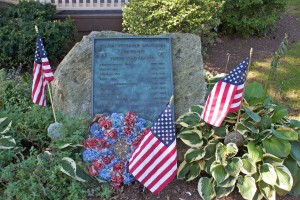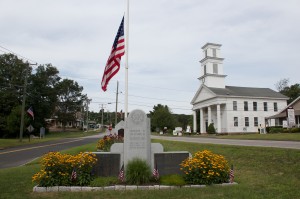 We first profiled the Soldiers’ Monument on the Guilford green in April of 2009, but last week we noticed that the monument is displaying a wreath for the holiday season.
We first profiled the Soldiers’ Monument on the Guilford green in April of 2009, but last week we noticed that the monument is displaying a wreath for the holiday season.
The base of the monument, made from pink granite that was quarried locally, was dedicated in 1877. The gray granite infantryman, supplied from a Massachusetts firm, was added to the monument 10 years later.
The monument’s south face bears a dedication reading, ““In memory of the men of Guilford who fell and in honor of those who served in the war for the Union, the grateful town erects this monument, that their example may speak to coming generations.”
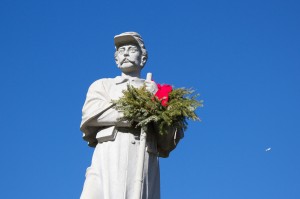 The south face also lists 14 residents who died during their Civil War service. The first name on the list is that of Uriah Parmelee, a Guilford native who left Yale during his junior year to serve in the Union Army. Parmelee was killed in April of 1865, and is also honored on the Yale Civil War Memorial in Woolsey Hall.
The south face also lists 14 residents who died during their Civil War service. The first name on the list is that of Uriah Parmelee, a Guilford native who left Yale during his junior year to serve in the Union Army. Parmelee was killed in April of 1865, and is also honored on the Yale Civil War Memorial in Woolsey Hall.
 Warren honors the service of its war veterans with a granite monument on a small green.
Warren honors the service of its war veterans with a granite monument on a small green.
The Warren Veterans’ Monument bears a dedication on its north face reading, “This memorial stands in honor of all the men and women from the Town of Warren who served our country in times of war.”
The undated monument, flanked by shrubbery, stands near a flagpole on a green at the intersection of Kent Road (Route 341) and Cornwall Road (Route 45).
 The fountain on the West Broad Street green in Stratford honors state legislator and attorney Stiles Judson.
The fountain on the West Broad Street green in Stratford honors state legislator and attorney Stiles Judson.
The fountain, at the west end of the green, features a bronze bust of Judson on its east face above an inscription reading, “Gift to his native town.”
The monument’s west face bears a dedication reading, “Stratford honors itself by accepting this memorial from Stiles Judson, a gifted son, a public official true to every trust, an able laywer, and a loyal citizen.”
The fountain, which was dedicated in 1916, included drinking troughs for horses on its sides, and troughs for dogs on its front and rear faces. The fountain is not active today (the troughs contain water, but you wouldn’t want to drink it).
 The fountain was designed by sculptor Bela Lyon Pratt, whose other works include the Nathan Hale statue at Yale, the Andersonville Boy monument on the grounds of the state capitol, the Hive of the Averys monument in Groton, and a number of other works.
The fountain was designed by sculptor Bela Lyon Pratt, whose other works include the Nathan Hale statue at Yale, the Andersonville Boy monument on the grounds of the state capitol, the Hive of the Averys monument in Groton, and a number of other works.
When it was dedicated, the fountain stood at the eastern end of the green, directly across from St. James Church. It was moved to the western end when Stratford’s War Memorial was dedicated in 1931.
Stiles Judson (1862-1914), was a Stratford native who practiced law in New Haven and Bridgeport. He served as state’s attorney for Fairfield County, and represented Stratford for several terms in the state House of Representatives and Senate.
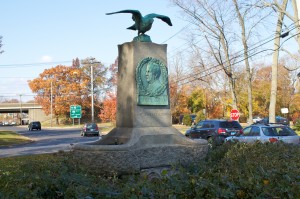 Judson financed the construction of the fountain honoring him with a bequest in his will. Pratt was paid $5,000 for the fountain (nearly $100,000 today).
Judson financed the construction of the fountain honoring him with a bequest in his will. Pratt was paid $5,000 for the fountain (nearly $100,000 today).
Tags: Stratford
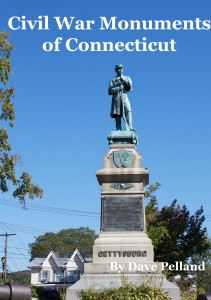 We’re pleased to announce the publication of Civil War Monuments of Connecticut, a 234-page guidebook highlighting 135 of the state’s Civil War monuments and memorials.
We’re pleased to announce the publication of Civil War Monuments of Connecticut, a 234-page guidebook highlighting 135 of the state’s Civil War monuments and memorials.
Most people who think of New England Civil War monument picture a granite solider standing on a pillar, but Connecticut’s monuments feature considerable design variations. In addition to infantrymen, you also see flag bearers, obelisks, archways, allegorical figures, domes and even simple plaques mounted on boulders.
Connecticut’s Civil War monuments were made of different materials — granite, marble, bronze and even zinc – and were dedicated at dates as early as 1863 (in Kensington) and as recently as 2011 (in Bristol and Hebron).
Regardless of the form, the intent of these monuments is the same – to honor the sacrifice of the residents killed in the war, show appreciation for those who served to defend the Union, and inspire future generations.
With detailed descriptions of the monuments, and information about each monument’s location, artist and history, Civil War Monuments of Connecticut is a helpful resource (and a great holiday gift) for Civil War and public art enthusiasts.
 Civil War Monuments of Connecticut also highlights monuments honoring veterans of the American Revolution, the World Wars, Korea, Vietnam and other conflicts.
Civil War Monuments of Connecticut also highlights monuments honoring veterans of the American Revolution, the World Wars, Korea, Vietnam and other conflicts.
Civil War Monuments of Connecticut is available in paperback and Kindle editions from Amazon.com.
 New Canaan honors its war veterans with several Honor Roll plaques in the lobby of Town Hall.
New Canaan honors its war veterans with several Honor Roll plaques in the lobby of Town Hall.
On the east wall of the first floor hallway, a plaque honors New Canaan’s veterans of the American Revolution, the Mexican-American War, and the Civil War. The American Revolution sections lists about 130 residents. The Mexican-American War section has two names, and the Civil War section lists about 225 names.
On the west wall, a plaque lists about 260 residents who served in World War I.
 Both plaques were dedicated in 1923.
Both plaques were dedicated in 1923.
In the front foyer, plaques honor residents who served in World War II, Korea, Vietnam and Desert Storm.
In front of Town Hall, an English Blakely Rifle has been mounted to honor New Canaan’s Civil War veterans. The cannon bears an undated plaque on its northeast face reading, “Presented to the Samuel P. Ferris Post No. 61 G.A.R. (Grand Army of the Republic) by the Howard M. Bossa Post No. 653 V.F.W. of the U.S.A.”
Samuel P. Ferris was a West Point graduate who served as colonel of the Twenty Eighth Regiment of the Connecticut Volunteer Infantry. The regiment, formed for a nine-month enlistment, recruited 678 men from Litchfield and New Haven counties. The regiment was involved in the capture of Port Hudson, Louisiana, in June of 1863 before mustering out in August of 1863.
 A granite tower in the Rockville section of Vernon honors local veterans of all wars.
A granite tower in the Rockville section of Vernon honors local veterans of all wars.
The War Memorial Tower, in Rockville’s Henry Park, stands at the summit of Fox Hill. The tower site includes a large plaza with a dedication plaque reading, “Memorial to the Veterans of Our Wars. Constructed by Works Progress Administration. Sponsored by the City of Rockville and the Town of Vernon, Connecticut, 1939.”
Plaques on the tower’s base honor veterans of the Army, Navy and Marine Corps, and bear the symbols of those service branches. We’re guessing the alcoves underneath the plaques once held markers listing local veterans, but could find no reference to when the plaques may have been removed.
 The tower was designed by architect Walter B. Chambers, whose works include two buildings on Yale’s Old Campus and a number of New York City buildings, and was modeled after a 1,500-year-old tower in France.
The tower was designed by architect Walter B. Chambers, whose works include two buildings on Yale’s Old Campus and a number of New York City buildings, and was modeled after a 1,500-year-old tower in France.
The site offers nice views of downtown Rockville and, on a clear day, as far as Mount Tom and Mount Holyoke. In the center foreground of our picture of the view, you can see Rockville’s 1890 Memorial Building, which was dedicated to honor local Civil War veterans.
Henry Park was donated to Vernon by E. Stevens Henry, a businessman and politician who served as mayor of Rockville, and was also elected to several state offices and the U.S. Congress.
 A brownstone monument in the Talcottville section of Vernon honors eight local residents who died during Civil War service.
A brownstone monument in the Talcottville section of Vernon honors eight local residents who died during Civil War service.
The monument, in Mount Hope Cemetery, was dedicated in 1869 and restored in 2008. The monument stands on a hill near the cemetery’s Elm Hill Road entrance.
The base of the monument’s front (south) face bears a dedication reading, “Erected to the memory of the soldiers from this place who gave their lives to their country in the War Against the Rebellion.”
The south face also honors two Vernon residents who died during in the war. Frank E. Stoughton, who served in the 14th Regiment of the Connecticut Volunteer Infantry, enlisted in July of 1862 and was wounded during the Battle of Gettysburg. Stoughton was discharged due to disability in 1865, and died on January 1, 1866.
 Horace Hunn, who served in the 16th Regiment, was wounded during the Battle of Antietam and died in a hospital on October 12, 1862. He is buried in the Antietam National Cemetery.
Horace Hunn, who served in the 16th Regiment, was wounded during the Battle of Antietam and died in a hospital on October 12, 1862. He is buried in the Antietam National Cemetery.
The 16th Regiment was formed in July of 1862 and left for Washington on August 29, 1862. The regiment saw its first action during the Battle of Antietam when the unit, barely trained, fought in the 40-Acre Cornfield.
The 16th sent 779 men into combat, and 43 were killed and 161 were wounded. A monument honoring the regiment was dedicated on the Antietam battlefield in 1894.
 The east face of the Talcottville monument honors Philip F. Foster of Vernon, another member of the 16th Regiment killed at Antietam. Like Hunn, Foster is buried in the Antietam National Cemetery.
The east face of the Talcottville monument honors Philip F. Foster of Vernon, another member of the 16th Regiment killed at Antietam. Like Hunn, Foster is buried in the Antietam National Cemetery.
The east face also honors Henry S. Loomis of Vernon, who drowned in the Potomac on April 24, 1865 (a little over two weeks after Lee’s surrender at Appomattox).
The north face honors two other members of the 16th Regiment: Alonzo Hills, who died as a prisoner of war in Charleston, South Carolina, on October 6, 1864; and James Bushnell, who died in a hospital on November 15, 1862.
 The west face honors Orrin O. Brown, who served with the 106th Regiment of the New York Volunteer Infantry. Brown died on April 22, 1863, while serving as part of a garrison protecting the Baltimore and Ohio railroad from Confederate raids in western Virginia.
The west face honors Orrin O. Brown, who served with the 106th Regiment of the New York Volunteer Infantry. Brown died on April 22, 1863, while serving as part of a garrison protecting the Baltimore and Ohio railroad from Confederate raids in western Virginia.
The west face also honors Frances Bantley, a member of the 6th Regiment of the Connecticut Volunteer Infantry. Bantley died in the Confederate prisoner of war camp at Andersonville, Georgia, and is buried in the National Cemetery there.
Tags: Talcottville, Vernon
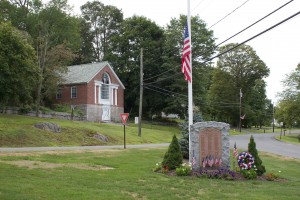 Harwinton honors its veterans of the World Wars, Korea and Vietnam with a monument on an historic green.
Harwinton honors its veterans of the World Wars, Korea and Vietnam with a monument on an historic green.
The undated monument, near the intersection of South Road and Litchfield Road (Route 4), stands near the north end of the green.
The monument is a granite block with an aluminum plaque on its front (north) face that bears an inscription reading, “Dedicated to those who served our country.”
Beneath the dedication, a section dedicated to World War I veterans lists nine names.
 A section listing World War II veterans includes 137 names, and honors nine who died during their World War II service.
A section listing World War II veterans includes 137 names, and honors nine who died during their World War II service.
The monument also lists the names of 37 residents who served in Korea, and 80 who served in Vietnam.
To the northeast of the monument, a 1976 historic marker erected by the town and the Connecticut Historical Commission provides a brief history of Harwinton.
To the east of the monument, the brick building in the left background of some photos is the 1915 Community Hall, which replaced a building erected around 1840. The original building served as Harwinton’s Town Hall and an Episcopal Church.
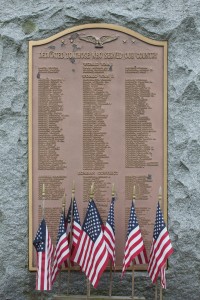 At the western edge of the green (part of the Litchfield-South Roads Historic District) stands a 2006 replica of a signpost that has stood, in one form or another, on the location for more than 200 years. In addition to directions and distances to nearby communities, the post was used to display municipal notices.
At the western edge of the green (part of the Litchfield-South Roads Historic District) stands a 2006 replica of a signpost that has stood, in one form or another, on the location for more than 200 years. In addition to directions and distances to nearby communities, the post was used to display municipal notices.
Tags: Harwinton
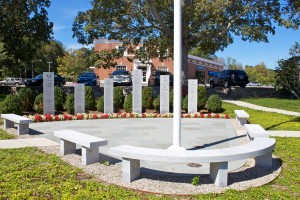 Wilton honors its veterans with a group of monuments in a plaza dedicated in 2010.
Wilton honors its veterans with a group of monuments in a plaza dedicated in 2010.
The Veterans Memorial Green, at the intersection of Center Street and Old Ridgefield Road, features granite columns of honors and benches. The site is dedicated to honor, “Wilton’s fallen heroes who made the supreme sacrifice in America’s wars.”
The collection of monuments includes six granite pillars inscribed with the names of local war heroes. The pillar honoring the French and Indian War, fought between 1754 and 1763, lists 10 residents.
 The American Revolution column honors 20 residents.
The American Revolution column honors 20 residents.
The Civil War has the largest grouping of names, with 34 residents being honored.
The World Wars and Korea share a pillar, with the World War I section listing two names; the World War II section listing 10, and the Korea section listing one.
The Vietnam and Iraq wars also share a pillar, with the Vietnam section honoring eight residents and the Iraq section listing one.
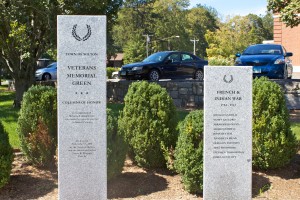 Veterans Memorial Green, a collaboration between the town and a local American Legion post, was designed by three architects.
Veterans Memorial Green, a collaboration between the town and a local American Legion post, was designed by three architects.
Nearby Memorials
Wilton veterans are further honored with a monument on the green a short distance south of the Memorial Green site. The memorial, dedicated in 1988, honors all veterans who served in the conflicts between the American Revolution and the Vietnam war.
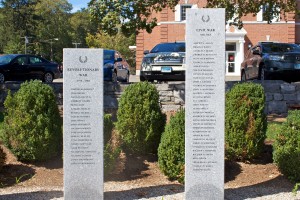 Heroes of the World Wars are also honored with a monument in Hillside Cemetery, about a half-mile northwest of the Memorial Green. A marker bears a dedication reading, “In memory of those who gave their lives [in] World Wars I and II,” above 10 names.
Heroes of the World Wars are also honored with a monument in Hillside Cemetery, about a half-mile northwest of the Memorial Green. A marker bears a dedication reading, “In memory of those who gave their lives [in] World Wars I and II,” above 10 names.
Tags: Wilton
 Burlington honors its war veterans and heroes with several monuments on the green at the intersection of Spielman Highway (Route 4) and George Washington Turnpike.
Burlington honors its war veterans and heroes with several monuments on the green at the intersection of Spielman Highway (Route 4) and George Washington Turnpike.
At the western end of the green, a memorial honors Burlington’s Civil War and World War I veterans. On the western side of the monument, a bronze plaque includes a dedication reading, “The Town of Burlington has not forgotten her beloved brothers who offered their lives to preserve the Union, 1861-1865.”
Beneath the dedication are 88 names of Burlington residents or natives who served in the Civil War, with stars indicating the 20 residents who died during their Civil War service. The Civil War plaque was dedicated in 1998.
 Among the veterans listed is Elijah W. Bacon, a private in the 14th Connecticut Volunteer Infantry who was awarded the Congressional Medal of Honor after the Battle of Gettysburg. Bacon captured the 16th North Carolina’s battle flag on the final day of the battle, was killed during the 1864 Battle of the Wilderness in Virginia.
Among the veterans listed is Elijah W. Bacon, a private in the 14th Connecticut Volunteer Infantry who was awarded the Congressional Medal of Honor after the Battle of Gettysburg. Bacon captured the 16th North Carolina’s battle flag on the final day of the battle, was killed during the 1864 Battle of the Wilderness in Virginia.
On the east face of the monument, Burlington honors its World War I veterans. The monument’s plaque includes a dedication reading, “Let us hold in honored memory those who served their country in the World War, 1917-1919.”
The World War I monument includes 42 names, and highlights five residents who died during their service.
 To the east of the Civil War and World War I memorial, an undated monument honors Burlington residents who served in World War II, Korea and Vietnam.
To the east of the Civil War and World War I memorial, an undated monument honors Burlington residents who served in World War II, Korea and Vietnam.
The western face of the monument bears an engraved eagle and an inscription reading, “Dedicated to the veterans of Burlington who served in the armed forces and died for our freedom.”
Beneath this dedication, a tablet lists 118 names of residents who served in Vietnam. The tablet further honors two residents who were killed.
The east face of the monument has the same dedication as the west side, and bears two plaques honoring Burlington’s World War II and Korea veterans. The World War II sections list 135 names, and honor seven residents who were killed. The Korea section lists 43 names.
Tags: Burlington












